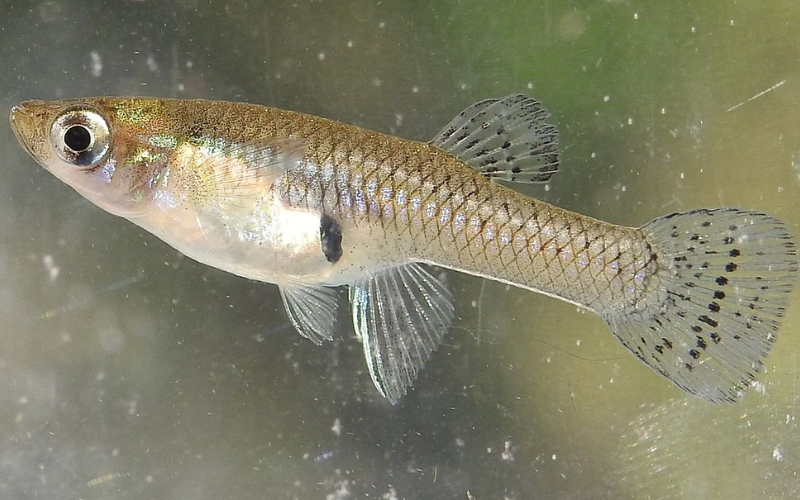Pregnant mosquito fish, scientifically known as Gambusia, exemplify a remarkable aspect of livebearing fish reproduction. These small, hardy fish, commonly found in freshwater habitats, display a unique ability to carry their developing embryos within their bodies. Female mosquito fish undergo a visually distinct transformation during pregnancy, with their abdomens gradually swelling as the embryos grow. The gravid spot, a darkened area near the anal fin, serves as a telltale sign, showcasing the presence of developing fry within the mother’s body. Their relatively short gestation period, lasting around three to four weeks, culminates in the live birth of free-swimming fry. This extraordinary reproductive process makes pregnant mosquito fish an intriguing subject of study for aquarists, scientists, and enthusiasts alike. Understanding the nuances of their pregnancies offers valuable insights into the diverse mechanisms of aquatic life and the intricacies of livebearing fish reproduction.
Introduction
Mosquito fish, scientifically known as Gambusia, are fascinating creatures that are commonly found in freshwater habitats. These small, hardy fish are known for their exceptional ability to control mosquito populations due to their voracious appetite for mosquito larvae. One of the intriguing aspects of mosquito fish is their reproduction process, particularly the unique nature of their pregnancies. In this comprehensive guide, we’ll delve into the fascinating world of pregnant mosquito fish, exploring their breeding habits, gestation periods, care, and much more.
Understanding Mosquito Fish Reproduction
Reproduction Process
Mosquito fish are livebearers, which means they give birth to live, free-swimming young rather than laying eggs. Their reproductive process is remarkably efficient, allowing them to multiply rapidly under favorable conditions. Female mosquito fish can store sperm from a single mating for an extended period, producing multiple batches of offspring from just one mating session.
Gestation Period
One of the most captivating aspects of pregnant mosquito fish is their short gestation period. Typically lasting around three to four weeks, the gestation period may vary depending on factors such as water temperature and the health of the female fish. During this time, the female’s abdomen visibly swells as the embryos develop, showcasing the gravid spot—a darkened area near the anal fin where the eyes of the developing fry become visible.
Identifying Pregnancy in Mosquito Fish
Physical Changes
Distinguishing a pregnant mosquito fish from a non-pregnant one involves observing specific physical changes. As the embryos grow, the female’s abdomen gradually enlarges, taking on a more rounded appearance. The gravid spot, mentioned earlier, becomes more pronounced and darker as the pregnancy progresses.
Behavioral Signs
Apart from physical changes, certain behavioral cues can indicate pregnancy in mosquito fish. Pregnant females may exhibit changes in their swimming patterns, becoming slightly less active or seeking shelter more frequently. Additionally, they might display increased appetite or a preference for secluded areas within the aquarium or pond.
Caring for Pregnant Mosquito Fish
Optimal Conditions
Providing a conducive environment is crucial for the well-being of pregnant mosquito fish. Clean, well-oxygenated water with suitable pH levels and adequate space for swimming is essential. Ensuring a balanced diet rich in protein and essential nutrients is also vital for the health of both the pregnant female and the developing fry.
Separation and Birthing
Given the predatory nature of adult fish, it’s advisable to separate pregnant mosquito fish from other tank inhabitants to protect both the expectant mother and her offspring. Once the female gives birth, promptly removing her from the birthing tank prevents her from consuming the newborn fry. Creating a separate nursery tank with plenty of hiding places, such as plants or fine-leaved structures, helps increase the survival rate of the fry.
Conclusion
Pregnancy in mosquito fish is a fascinating phenomenon that highlights the incredible adaptability and reproductive efficiency of these tiny aquatic creatures. Their ability to reproduce quickly and the unique livebearing nature of their young make them an intriguing species to observe and study. By understanding the signs of pregnancy, providing proper care, and creating suitable conditions, enthusiasts and hobbyists can ensure the health and well-being of pregnant mosquito fish and their offspring in aquariums or ponds.
In conclusion, the world of pregnant mosquito fish is captivating and offers valuable insights into the wonders of aquatic life, emphasizing the importance of responsible fishkeeping practices to support their thriving populations.




